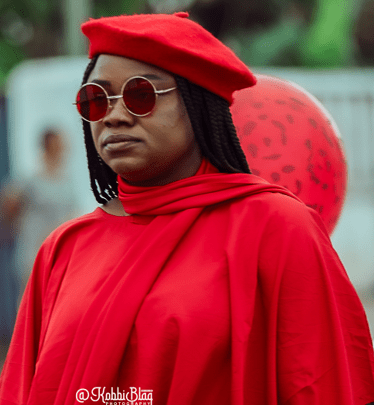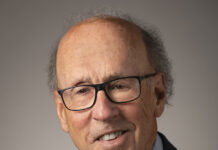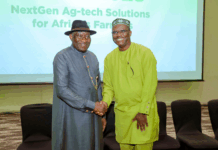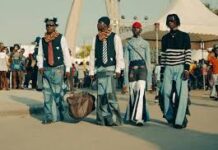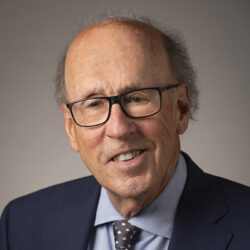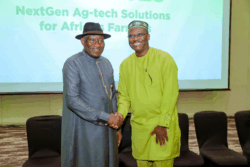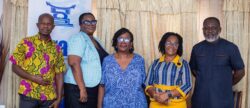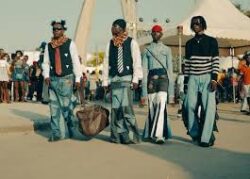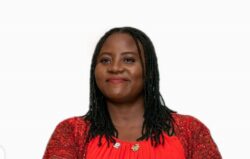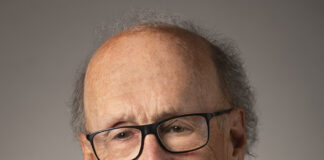By Anny OSABUTEY
Charity Derby Akeiti is a woman of many parts: artist-colour consultant, art journalist, arts coordinator, enterpreneur, painter, sculptor, graphic and textile designer. My first encounter with her was at the Nkyinkyim Museum in Ada.
She was part of a group of artists who had finished a mural on the museum’s wall. The project was to be unveiled at the museum’s annual Ancestor Veneration ceremony.
The mural came up around the time the George Floyd’s gruesome murder had inspired global protests. Though I did not speak to her or the team about the specific details, the painting somewhat had elements of the call for justice in there.
I have since been following her work and last year at the ChaleWote Street Art Festival, she was one of the artists assembled to curate works to give expression to the theme ‘Magneto Motherland’.
I watched her up-close and personally immortalised the memory of an enslaved African woman believed to have jumped into the Atlantic ocean in order to avoid being forced to work on slave plantations in America and the Caribbean. The woman thus became a deity and continues to inhabit among her people.
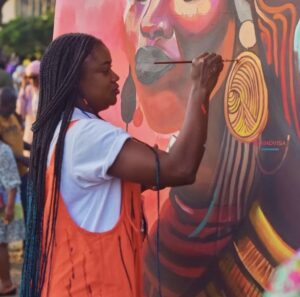
First time visitors to the mural were surprised about both the work and the embedded details. First joining the festival has an intern, she has become a constant part of the project, providing thought-provoking works around the various themes. She mesmerised the public this year with an equally compelling piece of art.
Born in Accra to both Ghanaian and Nigerian parents, Charity’s first encounter with the art started at a local art shop. Then eleven years of age, her mother – a trained nurse – sent her to the shop to keep herself busy. Inside the shop, the young future artist will learn how to paint boards for traditional games and masks used in celebration of the local festivals.

“With a ‘borrowed’ art teacher from a neighbouring school and constant visits to the National Art Gallery and Art Library in Lagos near my home at the time, I was led to take art as a major course in Senior Secondary School where most of my classmates dropped art in the final year,” she told me.
After taking up the art exams in the national examination and the Joint Admissions Matriculations Board Examination, Charity gained more experience in the production of hand-made educative posters, advertisements and basics in Colour Chemistry. Rather than going ahead with the programme, she deferred for a year in order to pursue a Diploma in Art studies in Ghana.

Despite being the only lady in an environment dominated by men, she secured an admission to the Delta State University, Abraka, Nigeria, and studied for a Bachelor of Arts in Fine Applied Arts. She majored in Graphic Design but took Sculpture as a three-dimensional, Painting, Textile and other art courses as elective courses in the second year of study.
For those familiar with the mural on the wall of the German-Swiss School around the Nima Police Station traffic light, that is one is of the many projects she has undertaken. Her portfolio of work is solid, establishing her as one of the sought-after Ghanaian artists in the art space.
Among other things, she is associated with the following: All-Female Art Mural Project for Freedom Parade, Nkyinkyim Museum, which I referenced in my introduction; then there is also a 2023 Act For Change ‘Sustainable Cities, Through My Eyes’ Art Exhibition and Schools Project in Accra.
She has also undertaken projects for the Federal Republic of Germany as well as served as a resource person for UNESCO World Book Capital. The project was in collaboration with the Ghana Museums and Monuments Board, Community Schools Poetry and Arts Festival, Accra-Ghana, March 2024.
For an artist with an accomplished body of works, Charity is a victim of the negative comments often directed at women in an environment some perceived to be the birthright of men. From being told that she is in a “useless career” to why as a “woman” she won’t find something “useful” to do with her life, she has heard it all. But resilient as she has always been, thanks to the support of her mother who first supported her decision to be an artist, she continues to go strong.
She often wonders how people still ascribe gender roles to work, even with the arts? How does one tell that a specific piece of art was done by a man or woman? She is, however, determined to change the narrative. “I wish to change the narrative and seek to challenge these stereotypes and break down barriers that limit the opportunities available to women in the art world. I hope to inspire other women to pursue their dreams.”
One of the things she has dedicated herself to is teaching female remand prisoners about the arts, and how they can use that as part of the rehabilitation process. “It has been quite a blissful journey. It came about through an official visit and discussion with the First Daughter, Gyankroma Akufo-Addo,” she said of the project.
There is an ongoing project inside the Osu Castle of which she is an integral part. Under the auspices of Christianborg Archaeological Heritage Project (CAHP), a non-governmental organisation, the group is engaged in an excavation exercise to find some important materials of historical value. The project is between CAHP and the artists and residents in Osu to collectively reimagine and invent their public spaces through illustration of community historical and cultural knowledge, as well as the reinforcement of the sense of community identity and well-being.
As the Founder and Chief Executive of the Art For Soul International – a gallery, residency and exchange programme, she organises and hosts international art exchange and residency programmes and fellowships. She also offers assisted studio time for international arts to explore ideas and culture.
A woman of few words but very gifted in her chosen profession, the happenings in her surroundings remain integral part of her creative process. She is also inspired by her mixed Ghanaian and Nigerian heritage. “I also think my inspiration is as a result of natural cause influenced by my roots of the fact that I am a native of Kinkanwe-Osu and also a native of Edo State (referred to as the Benin people), with its notable historic art pieces, including the mask of Queen mother Idia and the Benin bronzes.”
She said the sons of the Oba (Benin Monarch) were known to be blacksmiths and most descendants of this ancestry kingdom are artists; Work of iron, wood and ivory craftsmen with the history of using the lost wax technique of bronze casting.

